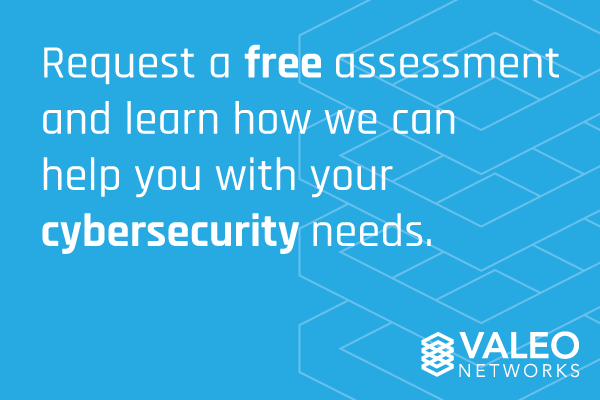5 Points to Consider for Cybersecurity Risk Management
Risk management has been a concept ingrained in all businesses since the inception of commerce itself. Cybersecurity risk management is a whole...
3 min read
Valeo Networks : Jul 17, 2020 4:00:00 AM
The idea that your organization is most likely safe from cybersecurity risk factors in today’s digital world is a losing proposition. Whether your enterprise is a global corporation or a small business, there are inevitable attacks that you and your data can fall prey to if you aren’t careful. It’s not all bad news, though! If you maintain a proactive and vigilant mindset, you can guard yourself from some of the most common errors that lead to cyber attacks and data breaches. Read below for a brief risk assessment of cybersecurity risk factors and the measures you can understand and implement.
Cybersecurity risks affect all businesses, no matter what size. It’s important that this ideology is maintained through ownership and executives, as the gravity of a breach is not just an internal dilemma – it can also severely damage your balance sheet!

Equifax and British Airways are just two notable companies to be fined multiple hundreds of millions of dollars for data breaches as the regulatory landscape is sharpening quickly. Your board needs to be apprised of the risk, and having a CISO role present is highly advisable.
Cyber attacks have existed since the internet transformed the business computing world in the 1980s. Through the following decades, threats have evolved past viruses and hackers, and now span a laundry list of malware including multi-vectored attacks such as WannaCry and NotPetya. These attacks are diverse and focus on exploiting weaknesses in networks, the cloud, and mobile devices all at once.
The advanced level of cybercriminals calls for an equal response of modern, multi-faceted cybersecurity. Autonomous security devices or blockchain-oriented implementation are two ways that you can protect yourself proactively.
If you have a vast network, identifying malicious cyber intruders can be a difficult task. However, the response is not to capture too much data through infrastructure and increased workforce cost – those can be mitigated by using sleek tools.
Notably, security softwares that perform diagnostics and study patterns of breach attempts will be as valuable as gold for your team. Machine learning and AI can similarly keep your defense efficient and quicker than any coordinated attack on your data.

Having assets allocated to prevent breaches is not enough in this day and age – you need to conduct cybersecurity risk assessments for each component of your business. Specifically, make sure each member of your team and every third-party is not a liability.
This is so important because human error remains one of, if not the preeminent contributors to at-risk cybersecurity. Over ninety percent of all organizational breaches come from phishing. In order to prevent lapses, you need to have a culture of caution, which means consistent training. Ultimately, watchful hiring practices and changing the habits of current employees will save you a headache.
On top of internal issues, it’s important that your partners and vendors don’t open you up to value-chain or third-party attacks. Nearly sixty percent of organizations have had a third–party breach at this point, and they are becoming increasingly costly- up to $370,000 more than the other average faults.
This is a recurring theme of this blog – having your data breached will cost money at every level, especially as regulators take a harder look at third-party cybersecurity protections. The bottom line is you need to have employees and partners that are in line with your security standards.
The statistical likelihood is that you will encounter a cybersecurity breach no matter the scale of your business. What separates the successful defense stories from the multi-million dollar examples made of failures is a strong incident response plan.
Companies that have a team or protocol dedicated to incident response experience over seven figures less per year in data breach costs versus teams that ignore this need. This response guideline should include cybercrime, outages, and data loss that would disrupt your operation.
We recommend starting with SANS Institute’s Incident Handler’s Handbook to begin developing your incident response plan.
.webp?width=600&height=400&name=VN-InlineImage-4-1%20(1).webp)
As attackers and their tools are becoming sharper, your cybersecurity must keep pace. Risk assessment of your executive team, employees, and practices are the bare minimum to keep yourself ahead of the curve in our increasingly connected world.
Be prepared to implement AI and advanced cybersecurity tools and treat any absence of them as seriously as attackers themselves. If you do this, you can create a complex range of measures and responses that will leave you resilient against cyber-attacks both in 2020 and going forward.


Risk management has been a concept ingrained in all businesses since the inception of commerce itself. Cybersecurity risk management is a whole...

Managed Service Providers (MSP) offer many benefits to your company. From cost savings to monitoring and minimizing security risks, an MSP will...

Disaster recovery is the area of security planning that deals with protecting an organization from the effects of significant negative events....

With cutting-edge technology and quality customer service,
you’ll find everything you need to help your company soar
with Valeo Networks.
1006 Pathfinder Way
Rockledge, FL 32955
Business Hours:
M-F: 8AM-9PM
© 2024 Copyright Valeo Networks. All Rights Reserved.